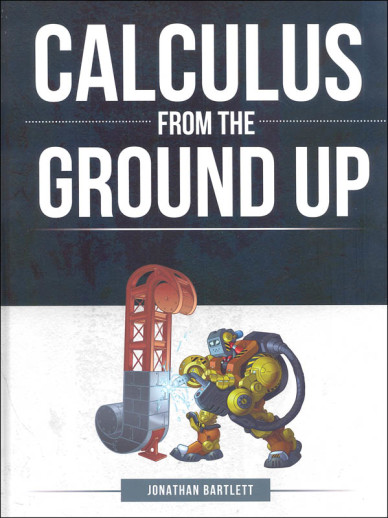We use cookies to make your experience better. To comply with the new e-Privacy directive, we need to ask for your consent to set the cookies. Learn more.
Calculus From the Ground Up Textbook
Calculus is one of humanity's greatest achievements. With calculus, you can analyze the infinitely large, the infinitely small, and everything in-between. Calculus gives you the tools to develop your own mathematics, your own formulas, and, most importantly, your own imagination. Calculus is not just a subject. It is an invitation to think differently about the way that the world works.
Calculus has a reputation for being a dry, dreary, difficult subject. However, the problem generally lies with tedious, lifeless books that present calculus with all the vigor of a wilted salad. Calculus was not discovered as a series of dull proofs about the real number line. It was discovered by curious people who took the time to look at the world in a new way.
Calculus from the Ground Up invites readers to not just read about mathematics but to become active participantsmaking numbers and symbols the servants of their minds as they grow their imaginations in ways they didn't think possible.
Calculus from the Ground Up isn't your typical mathematics book. It is a guidebook for students to learn not only the bare subject of calculus, but also to discover how its artistry impacts other areas of life. Calculus from the Ground Up includes sections on how to solve impossible problems, how to break problems into manageable sizes, how to develop new mathematical formulas, and even how to live a more ethical life, all through lessons gained from calculus.
This text is very well-done and would be a good follow-up to any precalculus/trigonometry course. The explanations are easy to understand and the author ties calculus concepts to real-life problems. The information is presented in a conversational tone, begins with the basics and builds to more complex concepts. This is a good traditional approach, employing the mastery approach with plenty of practice. Students should be able to manipulate equations, graph equations, analyze triangles, know the basic formulas for a line, area, quadrative, distance, Pythagorean Theorem, exponents, logarithms, etc. They should also be familiar with sin, cos, tan, inverse functions, and have an understanding of functions and how they work. There is a brief review in the first part of the book, and an appendix for reference if you need a bit of help. The Textbook is 446 uncluttered pages and is divided into 5 parts: Preliminaries, The Derivative, The Integral, Manipulating Infinity, and Appendices. The first four divisions or parts are divided into 31 chapters. The Solutions Guide offers worked solutions for the exercises found at the end of each chapter and explanations where needed.
This course is written by Jonathan Bartlett, who thinks math should be taught using a classical approach. In the grammar state students should learn to count, add, subtract, multiply, and divide. In the logic stage students should learn formulas. Calculus, in his opinion, is the gateway to the rhetoric stage and allows students to be creative. This is the time for students to create their own formulas and understand them and their origins. The focus of Calculus from the Ground Up is how math is invented, and how students can learn to be part of the creative process.
Each chapter is divided into sections (ex. 3.1, 3.2, etc.), offering explanations for each concept. New terms are printed in bold and a review that covers the topics of the chapter is included at the end of each. After the review section, students are provided wuth exercises for that chapter. Once a concept is taught with a thorough explanation, the explanation becomes less the next time the student sees that concept. By the third time a student sees that concept, it is assumed that they are familiar with it, and there is no explanation. Appendices are full of helpful information that students can use as a reference while working through the text.
The text is written to be taught over a one-year period of about 30 weeks – one high school credit. The author offers a suggested teaching schedule in Appendix A. ~ Donna
| Product Format: | Hardcover |
|---|---|
| Brand: | Bartlett Publishing |
| Author: | Jonathan Bartlett |
| Grades: | 11-12 |
| ISBN: | 9781944918026 |
| Length in Inches: | 11.375 |
| Width in Inches: | 8.75 |
| Height in Inches: | 1.1875 |
| Weight in Pounds: | 3 |

